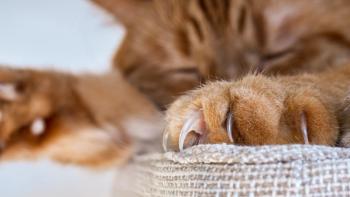
The 'rest' of the story
For most of the country, the wind blows and the snow swirls. It is not quite foaling season, too early for breeding and, except for those clients chasing points and heading to warmer weather competitions, things are relatively quiet for most equine practitioners.
For most of the country, the wind blows and the snow swirls. It is not quite foaling season, too early for breeding and, except for those clients chasing points and heading to warmer weather competitions, things are relatively quiet for most equine practitioners.
Paying attention to the 5 systems
Now is the time to get a bit of well-deserved rest.
It's probably a good time, too, to take a look at the basic concept of "rest" in an equine training and conditioning program; very few horsemen and women give this topic the attention it deserves.
Most owners and trainers spend a significant amount of their time thinking about their horse's conditioning, charting workout times, recording speeds and distances and assessing fitness.
Owners will consult with their veterinarians as to nutrition for these performance horses. Decisions will be made on soundness issues and plans formulated to promote foot growth, muscle development and joint wellness. They may request any number of tests to look at various blood parameters and may even seek veterinary advice as to the overall fitness of their equine athlete and its readiness for competition.
Addressing the need for rest
But few owners or trainers ask about rest.
How much rest does the performance horse need in a conditioning/training program? When do you implement that rest period? What constitutes the best method of rest for exercising horses? How long does it take a horse to get back into condition after a period of rest?
It is beneficial for equine veterinarians to understand the research behind answers to these questions and to be able to advise their clients on this issue. Overtraining (the result of too little rest) is a very real concern in competition horses, often leading to serious problems requiring veterinary attention. Proper rest for performance horses ultimately may help eliminate some of these problems.
"Preparation of a horse for competition involves a combination of training (schooling) and conditioning," according to Dr. Hilary Clayton, a leading sports-medicine researcher and director of the Mary Anne McPhail Equine Performance Center at the College of Veterinary Medicine at Michigan State University.
"Training develops neuromuscular coordination and mental discipline," Clayton says, "while conditioning induces physiologic and structural adaptations that maximize performance and maintain soundness."
Conditioning affects 5 systems
There are five systems in the horse — cardiovascular, muscular, nervous, thermoregulatory and support structure — systems that must adapt during physical conditioning and each has a different time schedule for that physiologic change.
The cardiovascular system must improve its capacity to deliver oxygen to working muscles. Muscles must improve their capacity to use that oxygen, increase their efficiency to use fuel and improve the mechanisms for the removal/buffering of the metabolic by-products of exercise.
The maximal rate of oxygen consumption (VO2max) is a measure of the ability of cardiovascular, respiratory and muscular systems to work at full capacity.
The most substantial increases in VO2max occur during the first two to three weeks of training, with a 9 percent increase occurring in just 10 days, according to one study of Thorough-breds performing moderate-intensity exercise.
VO2max improvements tend to plateau within six to eight weeks of training. Increases in plasma volume occur quickly, while increases in red blood cells, hemoglobin and muscle mitochondria and capillaries take longer (two to six months).
The horse's temperature regulatory system is extremely important to its ability to perform maximally. The horse must increase blood flow to the skin, improve its ability to sweat effectively and adapt so that it has an earlier onset of sweating with exercise. These changes may require a minimum of two weeks to occur.
The central nervous system of training horses also must respond to the particular demands of exercise. Quicker nerve responses and improved conduction times help with coordinated muscle activity and learned responses. These changes occur throughout the training process and can be very individualistic, with some horses progressing more quickly than others.
Supporting structures (bone, tendons and ligaments) must adapt to training and increase in size and/or strength. Unlike the four other systems however, changes occur much more slowly in these structures and a total conditioning time of six months or longer is considered normal.
Theses tissues cannot tolerate the rapid progression through training/conditioning programs that occurs with other systems. Bone density is a major determinant of strength, but increases in density are difficult to achieve in the horse.
Some recent studies show that short bouts of maximal exercise will improve bone mass and density, while longer training sessions at sub-maximal work will not. Yet maximal work may be contraindicated for conditioning tendons and ligaments that may not be able to tolerate speed work at the same stage of a conditioning program.
Because all of the other systems adapt much quicker, it is usually bones, tendons and ligaments that are the controlling factors for both the progression of training and the need for rest.
Sprains, strains, dorsal metacarpal periostitis, "bucked shins" and other supporting-structure problems often are the first indicators that some parts of the equine athlete's body cannot keep pace with its conditioning program.
Rest to avoid fatigue
"Overreaching" is the term for any number of short-term fatigue-related problems in training programs while "overtraining" applies to more serious, prolonged fatigue. Adequate and appropriately used rest periods are the proper means for avoiding both overreaching and overtraining.
Dr. Lori Warren is an equine nutritionist and exercise physiologist and is the Provincial Horse Specialist for the Alberta, Canada, Department of Agriculture, Food and Rural Development. "Too little stress on tissues will not produce a beneficial adaptation," says Dr. Warren as she describes the practical dilemma facing trainers. "But too much stress," she adds "or insufficient recovery time between workouts leads to a state of overtraining."
Overloading cardiovascular conditioning can lead to poor performance, poor appetite and an increase in packed cell volume (PCV). At one time this increase in PCV or red blood cell hypervolemia was considered a sign that the blood had become too thick, leading to poor performance. Owners, trainers, exercise physiologists and others had been looking for some type of "marker" for fitness. If such a blood value or chemical component could be identified, then one could evaluate how much training was too much and would know when to rest an equine athlete.
Many trainers wanted to use a test for PCV as a measure of overtraining in horses. Dr. L. Golland and other researchers from the faculty of Veterinary Sciences at the University of Sydney showed that, not only was this not a useful test for this condition, but that poor performance in overtrained Standardbred horses was not correlated to increased red cell hypervolemia. Trainers would have to look elsewhere.
Seeking a reliable marker
Plasma norepinephrine is another marker looked at as a measure of overtraining. Norepin-ephrine is a neurotransmitter in the sympathetic nervous system that increases heart rate, boosts breakdown of glycogen stores and the utilization of fats for energy. It enhances cardiac contractility and generally helps the body exercise more efficiently.
It was assumed that increases in norepinephrine would correlate to increased fitness and performance. Yet the reverse was found to be true. Increases in plasma norepinephrine were found to be associated with staleness in elite human swimmers and runners. It seems that this neurotransmitter's increase was the body's attempt to keep up with the effects of too much training. Drop-offs in norepinephrine levels actually indicated that the body had successfully adapted to a level of exercise and that the athlete was undergoing little stress while maintaining fitness.
This research is just beginning but studies in Australia are encouraging. Dr. Owen Anderson, a human exercise physiologist, writes, "Norepinephrine could serve as a decent and reliable marker of training progress and work-recovery balance. If norepinephrine shot up," he explains, "it could well be time to enhance recovery and cut back on total training load." Decreases in norepinephrine, conversely, would be a sign that the athlete was tolerating training well and becoming more fit.
Obviously this research must be repeated in horses but such a reliable marker could be a very useful tool.
Currently most trainers decide to rest their horses in training or to reduce the amount of exercise based on a seemingly non-scientific approach. Randy Harvey, a cutting-horse trainer at Rocking H Ranch in Georgia, explains, "It is different in each horse, but you just know which one is getting dull and needs a break and which one is asking for more work."
Questions and observation
This intuitive notion is echoed by other trainers in many disciplines and has more basis in science than might be expected. Dr. Anderson reports on the use of a "Profile of Mood States" (POMS) questionnaire in elite human athletes.
This series of about 30 questions has been given to athletes; their responses (evaluated in over 194 articles dealing with 32 sports) indicate their level of adaptation to training. According to Dr. Anderson, "POMS can be used quite successfully to assess performance status in athletes."
The questions range from "How well did you sleep last night?, How is your appetite?, How much muscle soreness are you experiencing? to questions about eagerness for today's workout and feelings of energy and vigor.
Athletes bordering on overtraining score poorly while competitors peaking and capable of maximal performance show rising scores.
The answers to these questions provide almost the same types of assessments that Harvey and most trainers make on their athletic horses simply by observing and monitoring appetite, attitude toward work, sleep and overall energy.
Paying attention to these signs, according to Dr. Anderson, "will encourage you to avoid hard training on days when you need an easy ride and to undertake challenging efforts when you are ready." Overall it will make you, or your horse, a fitter athlete.
How much rest?
Once you determine the need for rest, how does one determine how much? Rest for overreaching may be as simple as switching schedules to include a trail ride or a short session on a mechanical walker rather than regular exercise. It may require up to a week or more of turnout for more advanced cases or to allow strained muscles, tendons and ligaments to heal.
Evaluating parameters similar to those in the POMS questionnaire will alert trainers as to when a particular horse is ready to resume training. Improved muscle strength (evaluated at skill-specific tasks such as jumping, dressage movements, acceleration speed, turning ability), fewer sleep disturbances, reduced signs of stress and fatigue (appetite, haircoat), lower rates of exertion during exercise, lower heart rate during activity and brighter overall mood are the factors that researchers point to as signs that athletes have had enough rest and can resume training or safely push existing training programs to a higher level.
Each horse and each program will have to be evaluated individually, but these principles can provide a basis for incorporating rest into a training program.
Detraining
Occasionally periods of inclement weather, injuries or natural breaks in competition schedules will provide rest periods.
Taking a horse out of active training is called "detraining" and losses in cardiovascular, muscular and supporting structure condition will begin to occur as soon as training stops.
Detraining for a month or less results in minimal loss of cardiovascular fitness, especially if the horse has been in training for several months prior to an extended rest period.
Muscle condition and that of tendons and ligaments tends to fall off rapidly and takes longer to return, so extended lay-offs are not advised unless unavoidable. Ten days to two weeks of detraining at specific times throughout the competition year are beneficial. Trainers should look at their calendars so that horses can be rested and then brought back with enough time to ensure that they "peak" or are at maximal condition when major events occur.
Overall, rest and recovery periods are of crucial importance to training equine athletes. Rest gives nervous, endocrine, cardiovascular, muscular and supporting structures a break from the rigors of training and allows the body to repair, re-synthesize and recover.
As Dr. Anderson states, "an athlete's pattern of rest and recovery can make or break his/her entire training program."
Veterinarians can provide a service to their clients by advocating the inclusion of adequate rest periods for performance horses.
Dr. Marcella is an equine practitioner in Canton, Ga.
Newsletter
From exam room tips to practice management insights, get trusted veterinary news delivered straight to your inbox—subscribe to dvm360.






